Breastfeeding information & resources

Breast milk is the best food you can offer your new baby. The Canadian Paediatric Society recommends exclusive breastfeeding for the first six months of life. Breastfeeding early and often is important to increase your milk supply, reduce the incidence of engorgement and reduce jaundice in newborns.
At about six months, your baby will be ready for other foods, but you can continue breastfeeding until your child is two years of age and beyond.
On-site resources for people who deliver their babies at Sunnybrook
» Breastfeeding clinic
General information & resources
Some of the below resources have been adapted from Breastfeeding Matters/Best Start.
Learn how to establish a good milk supply
Firstdroplet.com offers information about establishing a good milk supply for term and preterm babies
First feedings
- Breastfeeding should begin as soon after birth as possible.
- Your nurse will help you get started.
- Hold your baby skin-to-skin, it might take an hour for your baby to latch on and start breastfeeding.
- Your baby's first weight, eye ointment application and Vitamin K injection can wait until your first breastfeeding is over.
Skin-to-skin
Skin-to-skin is a special way of holding your baby. As your baby grows, continue holding your baby skin-to-skin often and for long stretches of time.
Holding your baby skin-to-skin helps:
- Keep your baby's heart rate, breathing and blood sugar normal.
- Keep your baby warm through your body heat.
- You to get to know your baby.
- Your baby to be calm and cry less.
- You to be more confident and relaxed.
- You make more milk.
- Baby get a good latch which can prevent sore nipples.
Your partner or another person you are close to, can also provide skin-to-skin care.
Hand expressing colostrum or breastmilk
Hand expressing is a simple way to remove milk from your breast. Hand expressing is easy and takes a few minutes. Colostrum is the first milk. It is a yellow or clear or white fluid that you will make in the first 2 to 3 days after birth. Colostrum helps your baby's immune system and is very high in nutrients.
You can practice expressing colostrum as soon as your baby is born. It is normal to have only small amounts of colostrum, maybe drops to 1 or 2 teaspoons. This is enough for your baby. Hand expressing also helps your body make more milk.
When would I hand express?
- To make more milk.
- To get baby interested in latching by expressing a few drops on the nipple.
- To heal nipple soreness with a few drops left to dry on the nipple after feeding.
- To soften your breasts near your nipples if they are very full before latching baby.
- To make your breasts comfortable if they are full and baby is not feeding.
- If you are separated from your baby and not able to breastfeed right away, it is important that you hand express at least 8 times in 24 hours. If your baby is in the NICU ask your nurse for help and see the Mother's Milk Journal.
Massage your breasts before hand expressing or pumping
How to express colostrum/breastmilk for your baby:
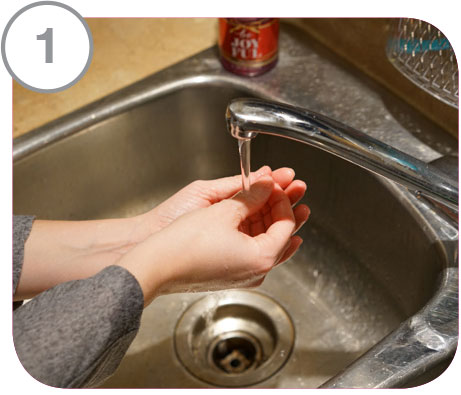
Wash your hands well and get comfortable.

Using your hands or fingertips, gently massage the breast.
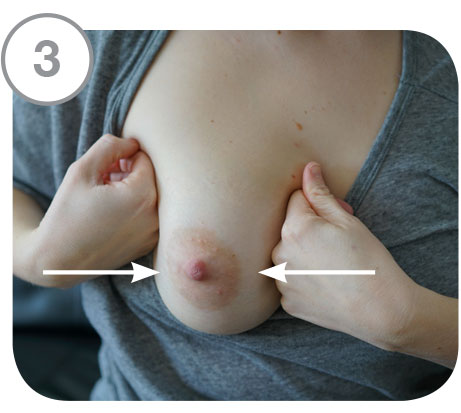
Some mothers prefer to gently use their knuckles to massage their breast.
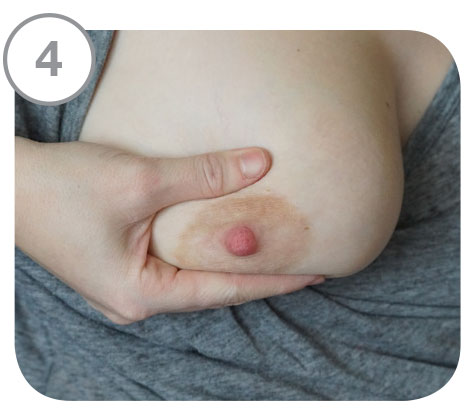
Place your thumb and
finger opposite each other about 2-3 cm from the areola.
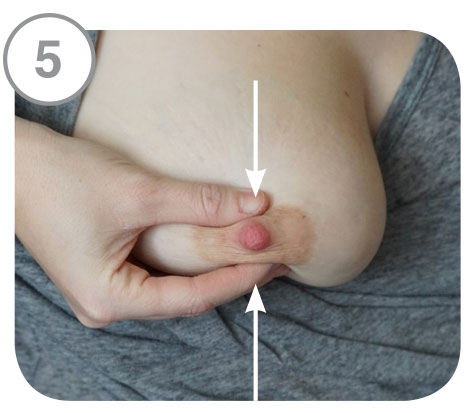
Press fingers towards your chest, then
compress and relax your fingers. Repeat this to copy baby's sucking.
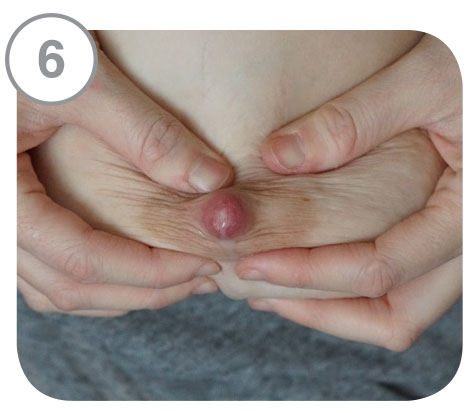
Your milk will start to flow. Even if your milk does not flow right away, hand expressing provides stimulation to make more milk.
Move your fingers to different areas around your breast so you are expressing from the entire breast. You may want to switch hands and switch from one breast to the other after 5 minutes.
It's a good fit!
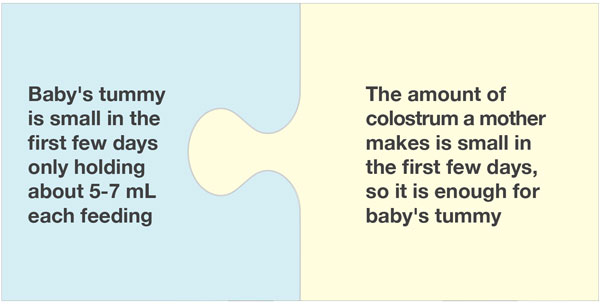
This is the size of your baby's tummy in the first few days: 
How can I tell if my baby is hungry?
Breastfeed your baby often. Most babies feed at least 8 times in 24 hours. Watch for your baby's cues. Feed baby whenever your baby is showing feeding cues. Babies will tell you when they are ready to feed and when they are finished.
Baby feeding cues (signs)
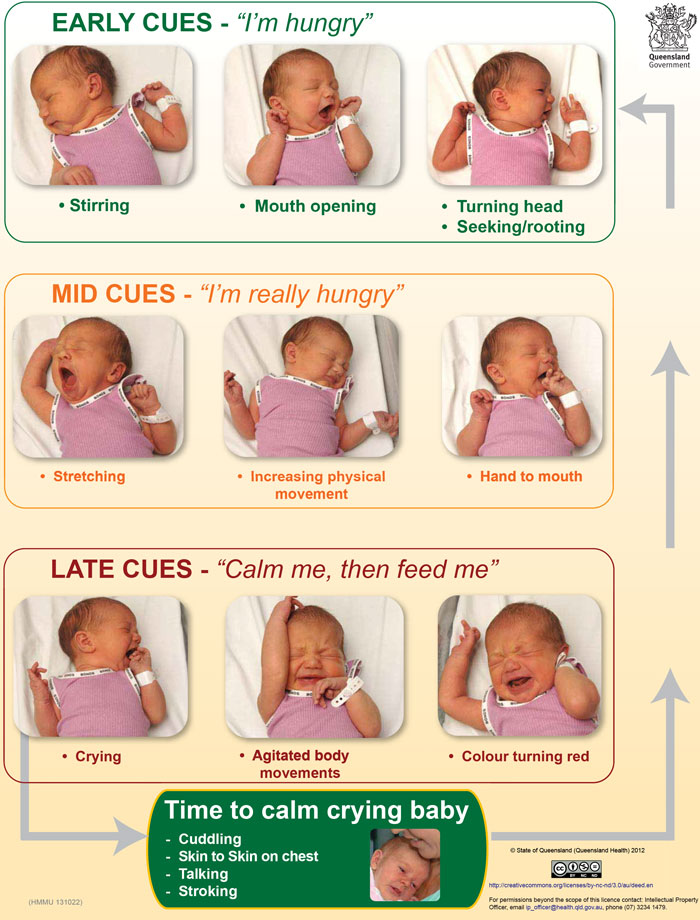
You cannot spoil your baby by holding and comforting. Babies develop best when their parents respond to their needs and hunger cues.
Babies cry for many reasons - discomfort, loneliness, hunger, fear, or being tired. Some babies cry more than others even when they are healthy and well fed. This happens more often in the first three months. It also happens more at night.
When your baby seems to cry for no reason you can try the following:
- If you know your baby has been well fed and burped, try
- skin-to-skin
- walking or rocking
- standing and swaying
- Change your baby's diaper if it is wet or dirty.
- Check if your baby is too warm or too cool.
- Offer your breast again. Use breast compressions and offer the first and second breast again.
- Try to calm yourself by counting slowly to ten or taking deep slow breaths. This may calm your baby as well.
- If you are getting upset, ask your partner or someone else to hold your baby while you take a break.
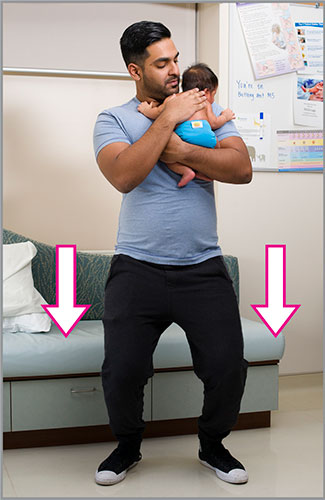
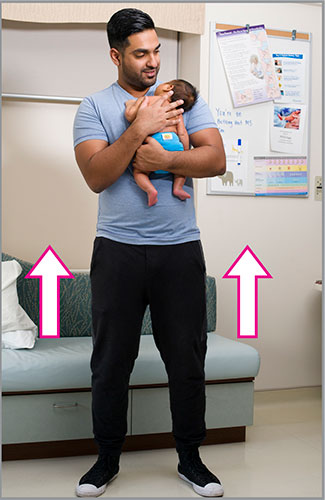
Moving baby in an up and down motion can calm your baby
Positioning and latching your baby
A good deep latch is very important
- Your baby gets milk easily
- Protects your nipples from damage
- Increases your supply
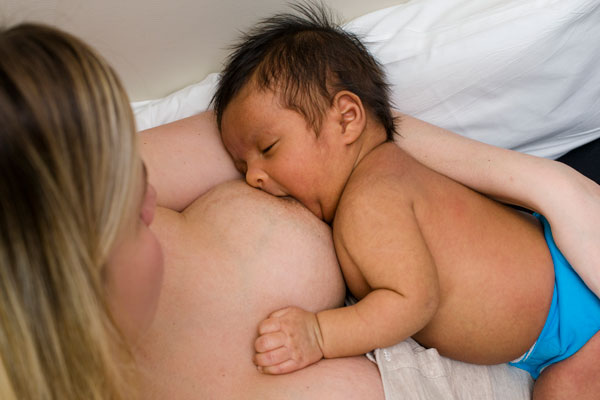
How to get your baby to latch well
- Turn baby with his "Tummy to Mommy".
- Tuck your baby's whole body in close, his bottom and legs too.
- Support your baby by holding your hand behind the shoulders and neck with the palm of your hand - "Face to Breast".
- Place baby were his nose is at the level of the nipple -"Nose to Nipple".
- Your nipple will be pointing upwards toward your baby's nose while you wait for his mouth to open wide.
- When bringing baby to breast, your baby's chin and lower lip should touch your breast first.
- Your baby will take all or most of the darker area around your nipple (your areola) into his mouth.
- If you have larger breasts, it may help to hold your breast by cupping it with your hand. Your fingers should be well back from the areola.
Don't push your baby's head onto your breast. Babies don't like getting pushed and may push back against your hand. This can make you think your baby does not want to feed.
Breastfeeding positions
Try different positions to see what works best for you and your baby
1. Laid back
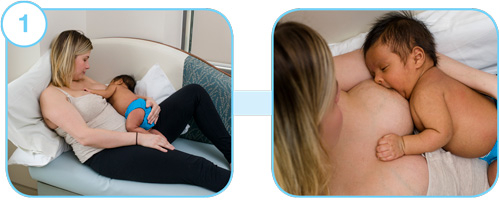
2. Cross cradle hold
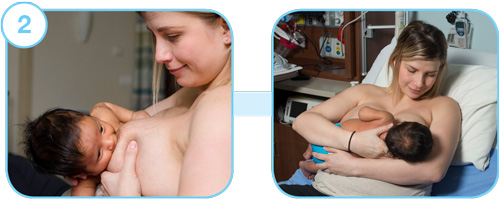
3. Football hold
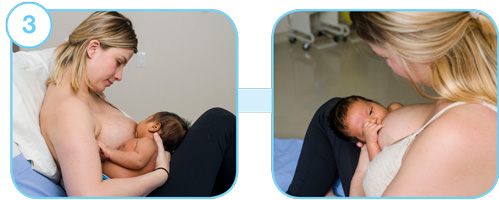
4. Side lying 5. Cradle hold
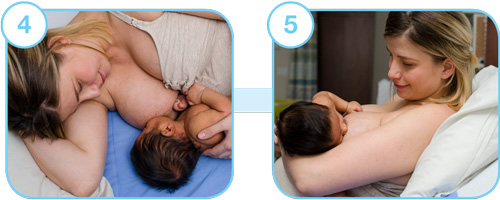
Common questions
How do I know if my baby is latched and feeding well?
You will know your baby is latched well when:
- Breastfeeding is comfortable and you are not in pain.
- You don't feel your baby pinching or biting your nipple.
- Your baby has a strong, slow, regular suck.
- You can hear swallowing.
- Your baby's mouth and lips are open wide.
- Your baby's jaw and ears are moving while baby sucks.
How do I know my baby is done feeding?
Some babies let go of the breast at the end of a feeding. However, if your baby has been pausing a lot and is no longer swallowing, you can take baby off your breast by slipping your finger between your breast and your baby's mouth to break the suction. Some babies always feed from both breasts, other babies do not. Some babies have a short nap and then take the other breast.
When your baby is finished feeding:
- Your nipples will have a normal, rounded shape and they should not look flattened.
- Your breasts may feel softer. You will see this more in the first few weeks of breastfeeding.
- Your baby should be relaxed and calm. Younger babies may fall asleep when they are done feeding.
- In time you will get to know your baby's cues. Sometimes you may just need to offer the breast again.
How long should I feed my baby?
You do not need to time your baby's feeds or worry about baby as long as baby:
- Feeds often, at least 8 times in 24 hours for at least 15-20 minutes.
- Feeds with strong sucking and swallowing.
- Has plenty of wet and dirty diapers for baby's day of age.
- Does not lose more than 10% of birth weight, baby has started to gain weight by day 5 and has regained birth weight by 2 weeks of age.
Babies feed for different lengths of time. Some babies feed regularly and quickly establish a routine. Other babies have short frequent feeds especially in the evening or at night. You will notice changes with the length of time your baby feeds depending on baby's age and growth spurts.
Feed your baby whenever baby shows feeding cues. Feed baby for as long as baby wants on both breasts. Babies know when they are hungry and when they are full.
Cluster feeding and growth spurts
Cluster feeding is when your baby feeds for a long time and does not settle. It is normal and helps you to make more milk.
Babies have some days when they need to breastfeed more. When this happens, some mothers worry that they do not have enough milk. This is your baby's way to help you make more milk.
These times are called growth spurts and they happen around:
- The 2nd night
- 10 days
- 2-3 weeks
- 6 weeks
- 3 months
- 6 months
Waking a sleepy baby
Some newborn babies are sleepy. That means your baby may not wake up to feed at least 8 times in 24 hours or your baby may latch but may fall asleep shortly after the feeding has started. Until your baby is waking up regularly and gaining weight steadily, you have to wake your baby.
Tips for waking a sleepy baby
- Unwrap and undress your baby. Change your baby's diaper.
- Keep your baby skin-to-skin so you can notice feeding cues. Babies can feed even when they are not fully awake or drowsy.
- Feed your baby as soon as baby shows feeding cues, or baby may go back into a deeper sleep.
- To learn about feeding cues go to page 14 of this booklet.
- Your baby will breastfeed more often when baby is kept skin-to-skin on your chest while you are awake.
- Lift baby to your shoulder and massage baby's body.
- Roll baby gently from side to side. Talk to baby.
- Express a little milk on your nipple when you bring baby to the breast to tempt baby.
- Use breast compressions during feeds to increase the amount of milk baby takes. This will help your sleepy baby to be more alert.
- Hand express after each feeding and give it to your baby by spoon or cup.
Breast compressions
- Some newborn babies fall asleep easily while they are feeding. To encourage your baby to keep feeding until baby is full, use breast compressions.
- While your baby is latched, gently squeeze your breast behind the areola to help your milk flow.
- Squeezing gently, compressing should not hurt.
- Compressions will express some milk and your baby may start sucking again.
- You can do this during the feeding or at the end of the feeding when your baby starts to get sleepy.
Burping your baby, how and when?
A breastfed baby does not swallow much air. Some babies become fussy if they need to burp.
Watch your baby to see how often baby needs to be burped.
- Some babies need to be burped during a feeding and again at the end.
- Some babies may not burp every time. Try burping for a few minutes only.
- Some babies spit up after feeding. As long as your baby appears content and gains weight, don't worry about spitting up mouthfuls of milk.
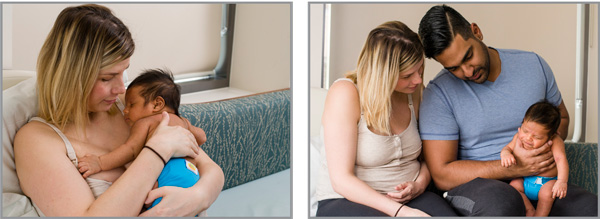
To burp your baby, hold your baby against your shoulder or sit your baby on your lap. Support baby's head and pat or rub baby's back. A bubble of air can come up more easily if baby's back is straight.
Should I use a pacifier?
Many breastfed babies never use a pacifier. The way babies suck on a pacifier is different from the way they suck at the breast. While your baby is learning to breastfeed baby may find it difficult to go from breast to pacifier and back again.
Early use of a pacifier can change the way your baby sucks at the breast. Pacifiers may:
- Cause mothers to make less milk.
- Cause babies to not gain weight well.
- Increase the risk of babies getting ear infections and having later dental problems.
If you decide to use a pacifier, only give it to your baby for a short time after feedings.
Signs that breastfeeding is going well
Is my baby getting enough milk?
Your baby is:
- Feeding at least 8 times in 24 hours.
- Active and has a strong cry.
- Sucking actively and you hear swallowing.
- Having enough wet and dirty diapers according to baby's age.
See chart below or visit the Best Start website.
| Baby's age | Wet diapers: How many, how wet, per day, on average over 24 hours |
Soiled diapers: |
|---|---|---|
| 1 day | At least 1 wet | At least 1 to 2 black or dark green |
| 2 days | At least 2 wet | At least 1 to 2 black or dark green |
| 3 days | At least 3 wet | At least 3 brown, green or yellow |
| 4 days | At least 4 wet | At least 3 brown, green or yellow |
| Day 5 to 3 weeks | At least 6 heavy wet with pale yellow or clear urine | At least 3 large, soft and seedy yellow |
What can I do to make a good milk supply?
- Start skin-to-skin contact with your baby as soon as your baby is born.
- Breastfeed your baby at least 8 times every 24 hours.
- Breastfeed your baby when baby is showing feeding cues.
- Hand express after each feeding and give colostrum to your baby by spoon or cup. Continue hand expressing after each feeding until your milk comes in (2-3 days after baby is born).
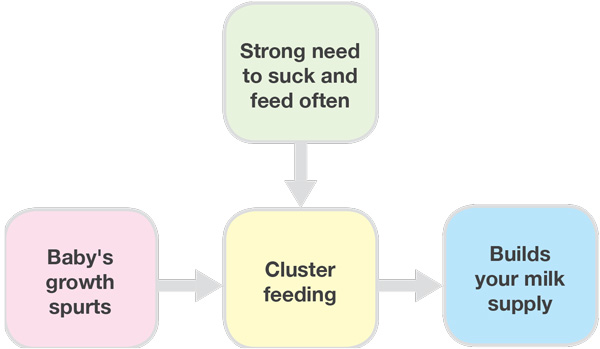
Wet (pee) and dirty (poo) diapers
- It can be helpful to record the number of wet and dirty diapers for the first week to make sure baby is getting enough.
- It can be hard for you to know if the diaper is wet. A very wet diaper is heavier than a dry one.
- Your baby's urine should be clear or pale yellow and have no smell.
- If a dirty diaper is heavy then count it as both wet and dirty.
Engorgement
Most mothers notice their breasts are larger, heavier and tender 3 or 4 days after the baby is born. This is called engorgement.
- Engorgement may last for about 48 hours and is caused by your breasts making more milk.
- Engorgement is common if you had a lot of IV fluids during labour.
- If your breasts become engorged, it may be more difficult for your baby to latch.
You can prevent engorgement if you:
- Breastfeed whenever your baby wants to, at least 8 times in 24 hours.
- Make sure your baby is latched and feeding well. You should hear swallowing often.
- Use both breasts at each feeding. If your baby will not take the second breast, and it feels very full, express enough milk from that side to make your breast feel more comfortable.
If your breasts are engorged:
- Breastfeed your baby more often.
- If your baby will not latch, express breast milk to soften the areola and then try again.
- You may wear a comfortable bra that is not too tight and without underwires. Some women wear no bra.
- Apply a wrapped ice pack to your breasts between feedings.
After your engorgement is gone your breasts will feel softer and less full. This is because the swelling has gone away. It does not mean you are making less milk.
Sore nipples
At first, most mothers feel a tug when their baby sucks. This can be uncomfortable. You should not experience any nipple pain.
The most common cause of sore nipples is an incorrect latch.
How can you tell you have an incorrect latch?
- Pain during feeding.
- Your nipples may appear pinched or flattened after feedings.
- Your nipples may be cracked, scabbed, blistered or bleeding. (swallowing blood from your nipples will not harm your baby)
To prevent and improve sore nipples make sure that
- Your baby has a wide open mouth and is latched on to the areola not just the nipple.
- Your baby's lips are open wide.
- Your baby's head is tilted back a little so baby can open his mouth wide.
- If you are holding the breast, that your fingers are positioned back from the nipple area.
If you have sore nipples
- Rub expressed breastmilk on your nipples after feeding.
- Air dry your nipples after feedings.
- Keep your nipples dry and change damp nursing pads often.
- Breastfeed on the least sore side first until your nipples feel better.
- Try laid-back breastfeeding, or different breastfeeding positions.
- If you are sitting up, support your breast during the feeding.
If you have made an informed decision to bottle feed your baby please let your nurse know so you can be given more information.
When and where do I get help?
While you are in hospital it is natural to need some help to learn to breastfeed.
- Your nurse can help you in your room.
- You can go to the Breastfeeding Class at 9:30 am every day.
If you have gone home from the hospital and you notice any of these signs:
- Your baby is nursing fewer than 8 times in 24 hours.
- After Day 4, your baby still has black stools.
- After Day 4, your baby has less than 3 dirty or less than 6 very wet diapers in 24 hours.
- Your baby is unusually sleepy, fussy or restless.
- Your nipples hurt, are cracked/bleeding, blistered.
- Your breasts feel hard and painful and you have flu like symptoms.
Supplementation
The World Health Organization and the American Academy of Pediatrics encourages the use of breast milk for the first 6 months following their birth. It is recommended that any additional supplementation be avoided during this time as it can disrupt breastfeeding and decrease your milk supply.
If you are unable to breastfeed because of medical or personal reasons please talk with your health care provider or nurse about safe recommendations for the use of formula for newborns. You can find more information on the Health Canada and Infant Feeding websites.
Birth control after baby is born
After your baby is born, it’s important to think about what’s ahead for you, including birth control. Breastfeeding can be used as birth control when, after giving birth, a woman breastfeeds her baby exclusively. That means the baby does not drink anything besides breast milk. Please visit the Planned Parenthood website for more information.
More resources
Please visit Toronto Public Health (see tab “Contraception, Birth Control”) for more details about how breastfeeding can be effective in preventing pregnancy.
Cluster feeding
During the first few days of age (days 1-4) your baby will have periods when they cry a lot and want to breastfeed very often.
Your baby is sucking to receive colostrum/milk as well as for comfort. This is normal baby behaviour. This frequent sucking helps you make more milk.
What your baby may do
- Need very long or frequent breast- feeding and does not settle after breastfeeding
- Wake often with hunger
- Need to be held & cuddled a lot
- Cry a lot - does not want to be put down
Babies have a strong need to suck. Frequent breastfeeding builds your milk supply.
Parents often feel:
- Tired
- Sleepy
- Frustrated
- Upset
- Worried they do not have enough milk
- Concerned their baby is hungry again so soon
Your baby will cluster feed again when they have growth spurts between 3-6 weeks, 2-4 months and 6-9 months.
What parents can do
- Keep breastfeeding your baby when they show feeding cues - mouth opening, rooting, hand to mouth, crying (often every 1-2 hours).
- Hand express drops of colostrum onto a spoon and give to your baby after each feeding.
- When your baby is not settling after taking both breasts, try latching again and switching from breast to breast until baby is settled.
- Try other positions; side lying or laid back positions - may be more restful.
- Keep your baby skin-to-skin after feeding until they get into a deep sleep before moving them.
- Your partner can hold and carry your baby if you need a break to rest. If your baby is still not settling keep breastfeeding.
- Try sleeping or resting when your baby sleeps.
- Ask your nurse for help.
Cannabis use while breastfeeding
No amount of cannabis — marijuana— has been proven safe to use during pregnancy or breastfeeding. Caution is warranted with any cannabis product, including CBD oil. Use during pregnancy or breastfeeding may be associated with short and long-term developmental issues for children.
Cannabis is stored and released from your body fat for a prolonged period of time, so “pumping and dumping” your milk after cannabis use will not eliminate the risk to your breastfeeding baby. Learn more.
Did you know you may be able to donate your extra breastmilk?
Please visit the Rogers Hixon Ontario Human Milk Bank to learn more about how to donate your breastmilk to hospitalized babies to help prevent life-threatening illnesses and infections. This non-profit organization is a joint initiative between Sunnybrook, Mount Sinai Hospital and the Hospital for Sick Children.
What are the benefits of human milk?
Human milk is the perfect food for the healthy growth and development of babies. Watch the Public Health Agency of Northern Ireland's video about human milk.
Additional resources
- Toronto Public Health
- La Leche League Canada
- Beststart
- Biological nurturing
- Breastfeeding Resources Ontario
- Breastfeeding Your Baby: Guidelines for nursing mothers (pdf file)
- Breastfeeding Matters (pdf file)
- Healthy Babies: Health Canada
- Breastfeeding: Canadian Paediatric Society
- Starting solids
- Why does my baby cry?
Videos:






